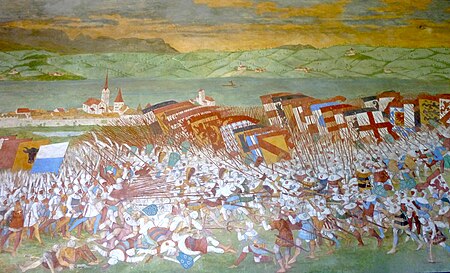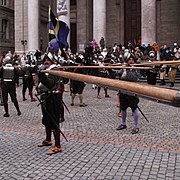
A pike is a long thrusting spear formerly used in European warfare from the Late Middle Ages and most of the early modern period, and were wielded by foot soldiers deployed in pike square formation, until it was largely replaced by bayonet-equipped muskets. The pike was particularly well known as the primary weapon of Swiss mercenary, German Landsknecht units and French sans-culottes. A similar weapon, the sarissa, had been used in antiquity by Alexander the Great's Macedonian phalanx infantry.
A schiltron is a compact body of troops forming a battle array, shield wall or phalanx. The term is most often associated with Scottish pike formations during the Wars of Scottish Independence in the late 13th and early 14th centuries.

The Landsknechte, also rendered as Landsknechts or Lansquenets, were German mercenaries used in pike and shot formations during the early modern period. Consisting predominantly of pikemen and supporting foot soldiers, their front line was formed by Doppelsöldner renowned for their use of Zweihänder and arquebus. They formed the bulk of the Holy Roman Empire's Imperial Army from the late 1400s to the early 1600s, fighting in the Habsburg-Valois wars, the Habsburg-Ottoman wars, and the European wars of religion.

The Swiss mercenaries were a powerful infantry force constituted by professional soldiers originating from the cantons of the Old Swiss Confederacy. They were notable for their service in foreign armies, especially among the military forces of the kings of France, throughout the early modern period of European history, from the Late Middle Ages into the Renaissance. Their service as mercenaries was at its peak during the Renaissance, when their proven battlefield capabilities made them sought-after mercenary troops. There followed a period of decline, as technological and organizational advances counteracted the Swiss' advantages. Switzerland's military isolationism largely put an end to organized mercenary activity; the principal remnant of the practice is the Pontifical Swiss Guard at the Vatican.

A charge is an offensive maneuver in battle in which combatants advance towards their enemy at their best speed in an attempt to engage in a decisive close combat. The charge is the dominant shock attack and has been the key tactic and decisive moment of many battles throughout history. Modern charges usually involve small groups of fireteams equipped with weapons with a high rate of fire and striking against individual defensive positions, instead of large groups of combatants charging another group or a fortified line.

A tercio, Spanish for "[a] third") was a military unit of the Spanish Army during the reign of the Catholic Monarchs and the Spanish Habsburgs in the early modern period. They were the elite military units of the Spanish Monarchy and the essential pieces of the powerful land forces of the Spanish Empire, sometimes also fighting with the navy. The Spanish tercios were one of the finest professional infantries in the world due to the effectiveness of their battlefield formations and were a crucial step in the formation of modern European armies, made up of professional volunteers, instead of levies raised for a campaign or hired mercenaries typically used by other European countries of the time.

An infantry square, also known as a hollow square, was a historic close order formation used in combat by infantry units, usually when threatened with cavalry attack. To deploy its weapons effectively, a traditional infantry unit would generally form a line; but the line was vulnerable to more nimble cavalry, which could sweep around the end of the line, or burst through it, and then attack the undefended rear or simply sweep along the line attacking the individual footsoldiers successively. By arranging the unit so that there was no undefended rear or flank, an infantry commander could organise an effective defense against cavalry attack. With the development of modern firearms and the demise of cavalry, the square formation is now considered obsolete.
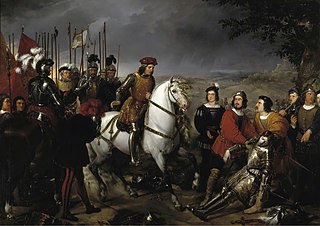
The Battle of Cerignola was fought on 28 April 1503 between Spanish and French armies outside the town of Cerignola, Apulia, Kingdom of Naples, approximately 80 kilometres (50 mi) west of Bari. The Spanish force under the command of Gonzalo Fernández de Córdoba comprising 6,300 men, including 2,000 Landsknecht pikemen, 1,000 arquebusiers and 20 cannons, defeated the French force of 9,000 men, mainly gendarme heavy cavalry and Swiss mercenary pikemen, with about 40 cannons, led by Louis d'Armagnac, Duke of Nemours, who was killed during the battle. It was one of the first European battles won by gunpowder weapons, as the attacks by the French cavalry and Swiss pikemen were shattered by the fire of Spanish arquebusiers behind a defensive ditch.

Line infantry was the type of infantry that composed the basis of European land armies from the mid-17th century to the mid-19th century. Maurice of Nassau and Gustavus Adolphus are generally regarded as its pioneers, while Turenne and Montecuccoli are closely associated with the post-1648 development of linear infantry tactics. For both battle and parade drill, it consisted of two to four ranks of foot soldiers drawn up side by side in rigid alignment, and thereby maximizing the effect of their firepower. By extension, the term came to be applied to the regular regiments "of the line" as opposed to light infantry, skirmishers, militia, support personnel, plus some other special categories of infantry not focused on heavy front line combat.
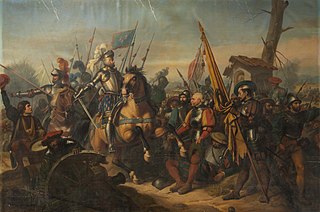
The Battle of Ceresole took place on 11 April 1544, during the Italian War of 1542–1546, outside the village of Ceresole d'Alba in the Piedmont region of Italy. A French army, commanded by François de Bourbon, Count of Enghien, defeated the combined forces of the Holy Roman Empire and Spain, commanded by Alfonso d'Avalos d'Aquino, Marquis del Vasto. Despite having inflicted substantial casualties on the Imperial troops, the French subsequently failed to exploit their victory by taking Milan.

Infantry tactics are the combination of military concepts and methods used by infantry to achieve tactical objectives during combat. The role of the infantry on the battlefield is, typically, to close with and engage the enemy, and hold territorial objectives; infantry tactics are the means by which this is achieved. Infantry commonly makes up the largest proportion of an army's fighting strength, and consequently often suffers the heaviest casualties. Throughout history, infantrymen have sought to minimise their losses in both attack and defence through effective tactics.

A close order formation is a military tactical formation in which soldiers are close together and regularly arranged for the tactical concentration of force. It was used by heavy infantry in ancient warfare, as the basis for shield wall and phalanx tactics, to multiply their effective weight of arms by their weight of numbers. In the Late Middle Ages, Swiss pikemen and German Landsknechts used close order formations that were similar to ancient phalanxes.

For much of history, humans have used some form of cavalry for war and, as a result, cavalry tactics have evolved over time. Tactically, the main advantages of cavalry over infantry were greater mobility, a larger impact, and a higher riding position.

Pike and shot was a historical infantry tactical formation that first appeared during the late 15th and early 16th centuries, and was used until the development of the bayonet in the late 17th century. This type of formation combined soldiers armed with pikes and soldiers armed with arquebuses and/or muskets. Other weapons such as swords, halberds, and crossbows were also sometimes implemented. The formation was initially developed by the Holy Roman Imperial (Landsknechte) and Spanish (Tercios) infantries, and later by the Dutch and Swedish armies in the 17th century.
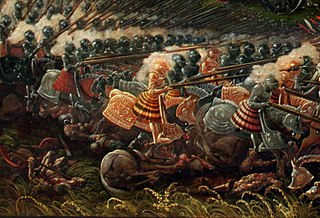
A gendarme was a heavy cavalryman of noble birth, primarily serving in the French army from the Late Middle Ages to the early modern period. Heirs to the knights of French medieval feudal armies, French gendarmes enjoyed like their forefathers a great reputation and were regarded as the finest European heavy cavalry force until the decline of chivalric ideals largely due to the ever-evolving developments in gunpowder technology. They provided the King of France with a potent regular force of armored lancers which, when properly employed, dominated late medieval and early modern battlefields. Their symbolic demise is generally considered to be the Battle of Pavia, which saw the gendarmes suffer a disastrous defeat and inversely confirmed the rise of the Spanish Tercios as the new dominant military force, leading to the preeminence of the House of Habsburg in 16th century Europe.
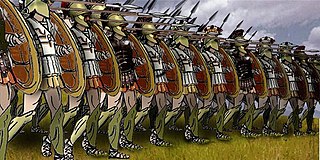
Heavy infantry consisted of heavily armed and armoured infantrymen who were trained to mount frontal assaults and/or anchor the defensive center of a battle line. This differentiated them from light infantry who are relatively mobile and lightly armoured skirmisher troops intended for screening, scouting, and other tactical roles unsuited to soldiers carrying heavier loads. Heavy infantry typically made use of dense battlefield formations, such as shield wall or phalanx, multiplying their effective weight of arms with force concentration.
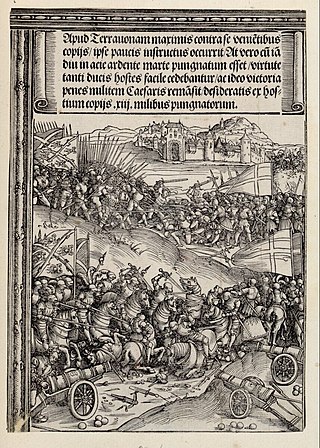
The First Battle of Guinegate took place on 7 August 1479. King Louis XI's French troops, led by Philippe de Crèvecœur d'Esquerdes, were defeated by the Burgundians, led by Archduke Maximilian of Habsburg. The battle was the first in which the innovative Swiss pike square formation was used by a power that was not natively Swiss.

Despite the rise of knightly cavalry in the 11th century, infantry played an important role throughout the Middle Ages on both the battlefield and in sieges. From the 14th century onwards, there was a rise in the prominence of infantry forces, sometimes referred to as an "infantry revolution".
Napoleonic tactics describe certain battlefield principles used by national armies from the late 18th century until the invention and adoption of the rifled musket in the mid 19th century. Napoleonic tactics are characterized by intense drilling of the soldiers; speedy battlefield movement; combined arms assaults between infantry, cavalry, and artillery; relatively small numbers of cannon; short-range musket fire; and bayonet charges. Napoleon I is considered by military historians to have been a master of this particular form of warfare. Military powers would continue to employ such tactics even as technological advancements during the Industrial revolutions gradually rendered them impractically obsolete, leading to devastating losses of life in the American Civil War, Franco-Prussian War and the First World War.

Although the term infantry dates from the 15th century, the foot troops of the previous eras in history who fought with a variety of weapons before the introduction of the firearms are also referred to as infantry. During the Ancient and Middle Ages infantry were often categorized by the types of weapons and armour they used, such as heavy infantry and light infantry. Generally, light infantry acted as skirmishers, scouts, and as a screening force for the more heavily armed and armored heavy infantry, the latter of which often made up the bulk of many historic armies.
